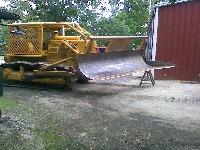- Posts: 1017
- Thank you received: 387

ACMOC Membership Benefits
- FREE quarterly magazine filled with content about antique Caterpillar machines
- FREE classified listings
- ACMOC store discounts and specials
- Full Bulletin Board Access
- Marketplace (For Sale/Wanted)
- Technical Library
- Post attachments
$44 /year ELECTRONIC
$60 /year USA
$77 /year International
Where aftermarket sleeves come from.
- trainzkid88
-

- Offline
- Platinum Boarder
- Member
Please Log in or Create an account to join the conversation.
D2, D3, D4, D6, 941B, Cat 15
Hancock Ma and Moriches NY
Please Log in or Create an account to join the conversation.
Please Log in or Create an account to join the conversation.
Please Log in or Create an account to join the conversation.
On the main machine the operators had to level the sand out on the mold box before a massive hydraulic cylinder compacted the sand and then another operator put the cores into the mold. The machine assembled both halves of the mold and transferred it to the melt deck where the melt crew poured the molds. We had a 15 ton furnace and a 3 ton furnace when I first started and they were replaced with one 5 ton furnace which could out melt the 15 ton furnace.
We used to take a sample from the furnace and pour a small mold and cool it and test it and that would decide how much additive was needed to bring the metal into spec. The additives were added to the molten metal when it was poured down a launder into a ladle for pouring into the molds. The only thing we used to call a crucible was the little pot on a stick to get a sample from the furnace.
I can't remember the name of the lining for the furnace, launder and ladles but I don't remember it being graphite, I think it was some sort of ceramic. It was loose like powder and was packed around a steel core in the furnace and then the furnace was turned on and the core melted and became part of the next pour. It would last about a month and then it would have to be replaced. It came out like concrete. The top foot or so was chipped out by hand and then the furnace was tilted and a big hydraulic cylinder was attached to the base and the rest was pushed out.
Charging the furnace was the dangerous part as the scrap had to be dry and free of aluminum cans or anything that could hold moisture. We had a big explosion there one day when a charge that was dropped into the furnace contained trapped moisture. Water instantly turns to steam when dropped into molten metal and can cause a molten metal shower to explode from the furnace. Luckily on our explosion no one was hurt.
944A - Machine SN 43A2589 Engine SN 90A284
955K- Machine SN 71J3772 Engine SN 83Z0704
D6 SN's 4R732sp, 5R2724, 5R4832
D8 SN's 15A1254, 15A2287, 15A2723
Please Log in or Create an account to join the conversation.
- trainzkid88
-

- Offline
- Platinum Boarder
- Member
- Posts: 1017
- Thank you received: 387
the qld premier in the 80s was sir Joh, now Joh was staunch anti trade union he believed this shop needed a trade union. 2 youngish blokes were killed there 70s/80s when a cylinder of acetylene made from calcium carbide exploded old george still had the gas producer over 20yrs later and a couple of 44gal drums full of calcium carbide chunks.
george was a cantankerous old barstard but what he didn't know about about making non electronic farm machinery and blacksmithing possibly wasnt worth knowing.
Please Log in or Create an account to join the conversation.
Cat 12 grader, 8T6995 running and restoring, Cat 12 grader 9K3585. parts machine, Adams leaning wheel Pull grader Mod # 22, ser#438
Please Log in or Create an account to join the conversation.
ACMOC
Antique Caterpillar Machinery Owners Club
P.O. Box 9301
Peoria, IL 61612
(309) 691-5002
cat@acmoc.org
"I became a member recently because the wealth of knowledge here is priceless."
- Chris R
"I also joined a year ago. had been on here a couple of times as a non-member and found the info very helpful so I got a one year subscription (not very expensive at all) to try it out. I really like all the resources on here so I just got a three year. I think its a very small price for what you can get out of this site."
- Jason N


